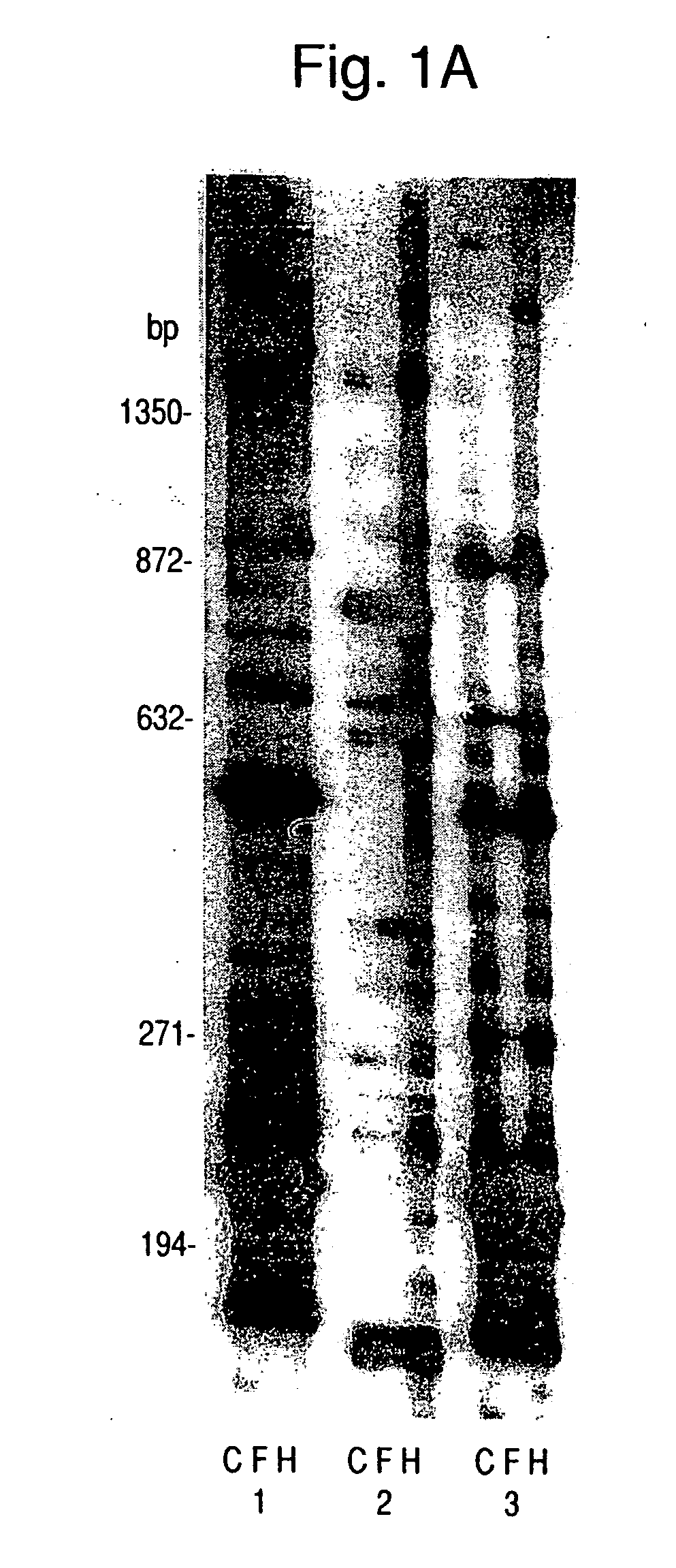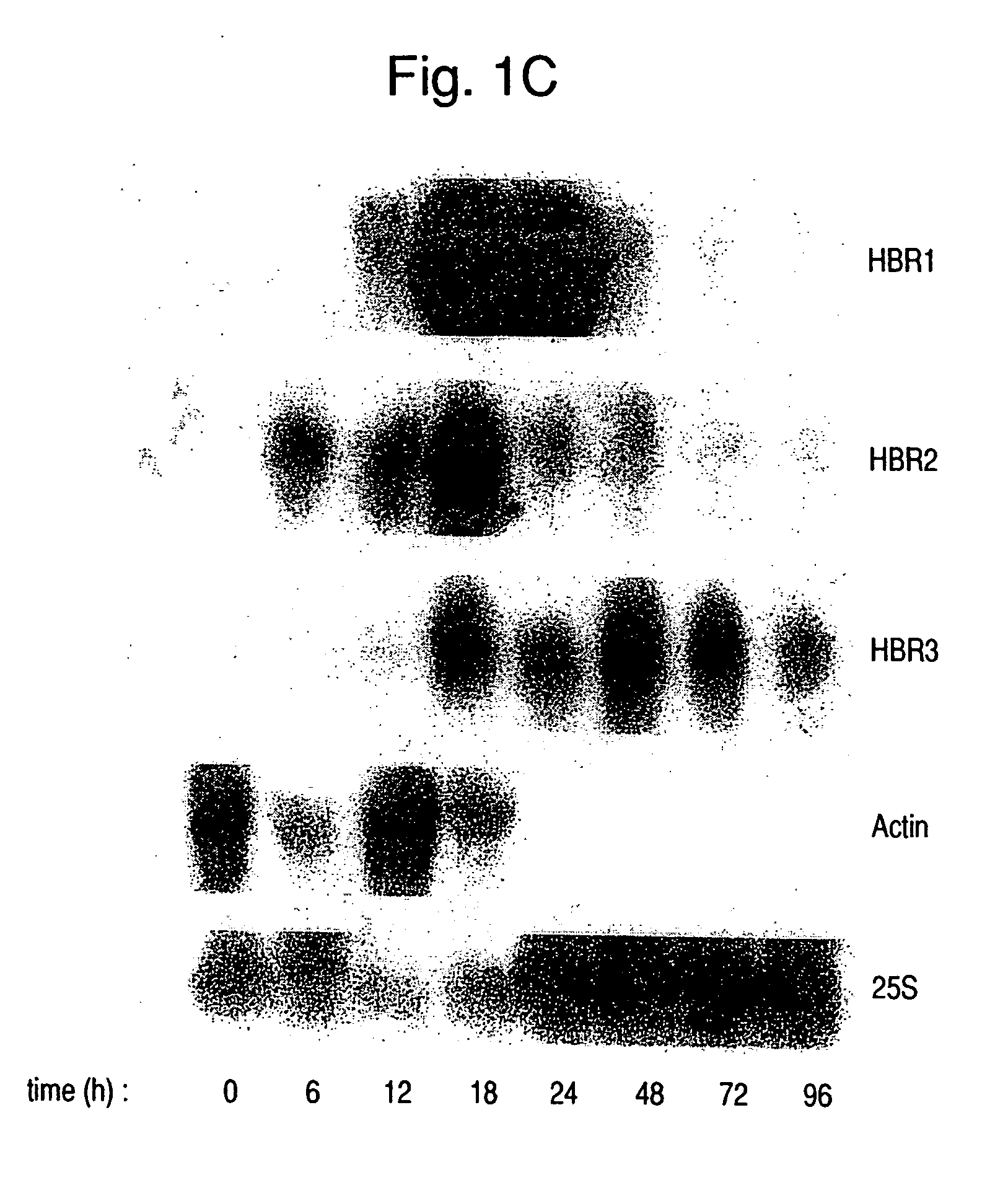Nucleic acid and amino acid sequences of hemoglobin-response genes in Candida albicans and the use of reagents derived from these sequences in the diagnosis of disseminated Candida albicans infection
- Summary
- Abstract
- Description
- Claims
- Application Information
AI Technical Summary
Benefits of technology
Problems solved by technology
Method used
Image
Examples
example 1
Hemoglobin Specifically Alters Expression of Multiple Genes
[0080] To understand the basis for the altered expression of cell surface proteins in C. albicans cells grown in the presence of hemoglobin (22), random arbitrary primed-PCR was used to examine changes in mRNA expression in C. albicans induced by hemoglobin. Expression patterns were compared to untreated control cells or cells treated with equivalent concentrations of ferrous sulfate to exclude those mRNAs induced by iron that may be released by degradation of the added hemoglobin (FIG. 1A). Some of the differentially expressed PCR products were induced by either inorganic iron or hemoglobin (FIG. 1A, **), whereas others were specifically induced (*) or inhibited (−) by hemoglobin.
[0081] cDNAs for the differentially expressed genes were amplified, subcloned into a TA cloning vector, and sequenced. A total of 33 ESTs that exhibited increased expression in cultures supplemented with hemoglobin but not in cultures supplemente...
example 2
Characterization of Hemoglobin-Response Genes
[0084] A C. albicans genomic library was screened using probes derived from three cloned ESTs (SEQ ID NOS:11-13) that were confirmed to be positive by Northern blots. HBR1, HBR2, and HBR3 (SEQ ID NOS:1-3) are novel genes, each of which showed limited homology to hypothetical proteins of Saccharomyces cerevisiae (Table 1). These genomic clones were mapped to distinct chromosomes (Table 1). Therefore, the hemoglobin-response genes are not physically associated, in contrast to the host-response genes of some pathogenic bacteria which are frequently clustered in pathogenicity islands (3).
TABLE 1Properties of Hemoglobin-Induced Genes1HemoglobinHyphalC. albicansS. cerevisiae homologsGeneresponseresponseChromosome(% DNA homology)ORF FeaturesHBR1++++1 SfiI frag SYDL166C (62%)ATP / GTP-bindingsite motif (P loop);phosphorylationsites for PKC,PKA, CK2HBR2++o6 SfiI frag CYFL030W (72%)pyridoxal phosphatemotifHBR3+++o1 SfiI frag EYOR056C (34%)HBR4++oH...
example 3
Induction of Hemoglobin-Response Genes by Whole Blood
[0085] Pathogenic isolates of C. albicans express a hemolysin that could release hemoglobin from erythrocytes when the pathogen gains access to the vascular compartment (23). As predicted from this observation, exposure of C. albicans to whole blood in vitro at 26 or 37° C. for 5 h resulted in rapid induction of HBR1 and HBR2 expression (FIG. 2A). The ATCC 44807 strain used for these experiments was verified to express hemolytic activity following growth on Sabouraud dextrose agar containing rabbit blood and 3% glucose (FIG. 2B). Strain ATCC 32354 was reported previously to produce hemolytic factor (23) and used here as a positive control.
PUM
| Property | Measurement | Unit |
|---|---|---|
| Affinity | aaaaa | aaaaa |
Abstract
Description
Claims
Application Information
 Login to View More
Login to View More - R&D
- Intellectual Property
- Life Sciences
- Materials
- Tech Scout
- Unparalleled Data Quality
- Higher Quality Content
- 60% Fewer Hallucinations
Browse by: Latest US Patents, China's latest patents, Technical Efficacy Thesaurus, Application Domain, Technology Topic, Popular Technical Reports.
© 2025 PatSnap. All rights reserved.Legal|Privacy policy|Modern Slavery Act Transparency Statement|Sitemap|About US| Contact US: help@patsnap.com



